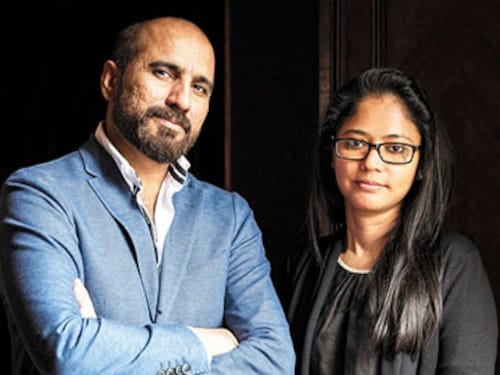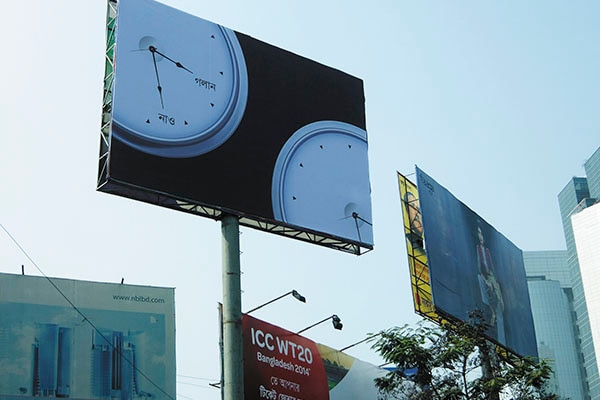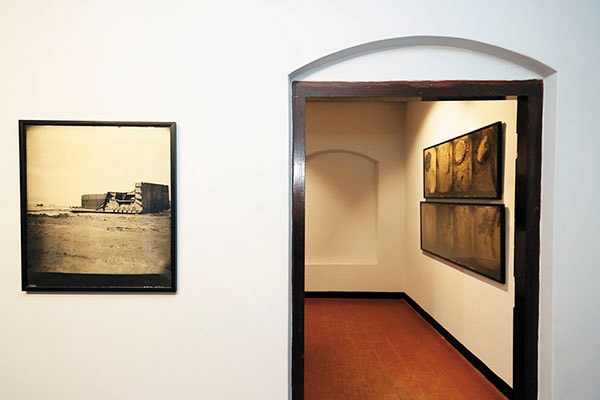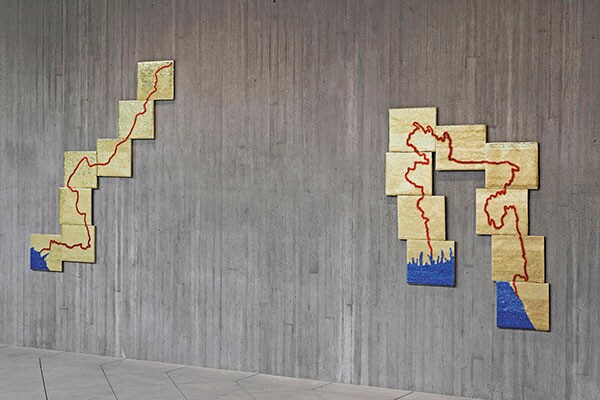Art sans frontià¨res
In the absence of government support and cooperation, cross-border collaboration and promotion of art in South Asia is resting on private shoulders


South Asia: A geography that has experienced seven wars, and severe internal and external insurgencies in the 70 years since the end of colonial rule that is home to two of the eight nuclear powers in the world that has long-standing, bitter border disputes and unresolved issues of political identities.
South Asia: A geography that is home to more than a quarter of the world’s population that has the world’s most diverse set of languages, dialects and religions, and yet has a history as intertwined as its mythologies, food, music and cinema.
You cannot possibly look at one set of data, and not look at the other.
And a fine example of this other, this ‘soft’ set of data, is playing out close to 6,000 km away at the ongoing 56th Venice Biennale this year. For the first time, India and Pakistan have a joint exhibition—My East is Your West—at the biennale, where India last had a presence in 2011 and Pakistan in 1956.
The exhibition is an achievement because of several factors, but it is also symbolic of several more. And the most glaring perhaps is the fact that the joint Indo-Pak presence is termed an ‘exhibition’—an official collateral event—and not a ‘national pavilion’ like entries from other countries for, a national pavilion would mean governmental representation and support, something that is absent from this exercise. The government—not just of India, but of other South Asian nations too—is perhaps most prominent by its marginal presence in the region’s art scene. And filling in the role has been a clutch of private art foundations, galleries, curators and artists who are enabling cross-border collaborations, movement and promotion of artists and artworks.
“The understanding that private art foundations and philanthropists have of the region is a more holistic one,” says Mortimer Chatterjee, co-founder of the Chatterjee & Lal gallery in Mumbai. “The anomaly lies in the minds of the governments. There is no anomaly in the minds of the people. Rashid [Rana] is as much a part of the history of the Indian contemporary art scene as he is of the Pakistani scene.”
In the absence of much funding from the government, private enterprises, both commercial and otherwise, play a perceptible role in the growth, promotion and mobility of art, points out Rashid Rana. “In many respects, the art market can be more democratic because it doesn’t conceive value in a nationalistic sense. Commercial galleries participating and putting up diverse presentations at events such as the India Art Fair and the Dhaka Art Summit are testament to this,” says the Lahore-based artist, who works with photography, sculpture and digital print-making. Image courtesy of The Artists Samdani Art Foundation, photp credit: Shumon Ahmed
Image courtesy of The Artists Samdani Art Foundation, photp credit: Shumon Ahmed
Artworks put up on hoardings around the city by the Raqs Media Collective at the Dhaka Art Summit in 2014
“Venice was a great leap of faith,” says Feroze Gujral, who heads the Gujral Foundation along with husband Mohit, which made it possible for artists Shilpa Gupta from India and Rana from Pakistan to present their creations at the biennale. “It’s a platform where we should appear for two important reasons: One, because Venice is the Olympics of the art world. Do we not send people to the Olympics, or to the World Cup? It is important to look at culture at that level. Just because it does not make us the same kind of TV money [from advertising revenues], does it mean we don’t do it? The second reason is: How can you have a global platform without one quarter of the world’s population being represented?”
The Gujral Foundation’s work involved everything from raising money and arranging the logistics of putting up the show at the Palazzo Benzon to facilitating the work between Gupta and Rana.
And it has not been easy. Even within the space of corporate and private funding, Gujral highlights the difficulties of convincing people of the need to promote art and support artists.
“In other countries, there is a fundamental understanding of how important these events are for the perception of the country as a whole, and not just about the art scene,” says Amrita Jhaveri, art collector and owner of Mumbai gallery Jhaveri Contemporary. “Those are just not priorities for our government. So, obviously we don’t have national pavilions. And despite the fact that the Gujral Foundation has one member of the family who was a former prime minister [IK Gujral], and another member a leading artist [Satish Gujral], if they cannot get the funding from within our country, then what hope is there for normal people?”
If the Gujral Foundation in India has made India’s and Pakistan’s presence at the Venice Biennale possible (along with supporting various other art events since 2008), the Samdani Foundation in Bangladesh has been behind the Dhaka Art Summit. The third edition of the summit is scheduled for next February, and is the cause of much excitement and anticipation within the art fraternity.
The Samdani Foundation, founded in 2011 by collectors Nadia and Rajeeb Samdani, has been instrumental in bringing global attention to South Asia—curators who have worked on past editions of the summit include Aurélien Lemonier from Paris, Daniel Baumann from Zurich and Katya García-Antón from Norway—as well as creating a distinct identity for Bangladesh within the region. “The summit exists as a platform because there is no place in the world to go to see work from South Asia under one roof,” says Diana Campbell Betancourt, artistic director of the summit. “Also, people don’t know what South Asia is we get emails asking us about China and Thailand, and countries that aren’t really involved. We have works from every country in the region except from Bhutan. And we are working on it.”
Betancourt, however, adds that the summit has been helped immensely by the government’s support through the availability of the venue—the Bangladesh Shilpakala Academy. “The fact that this is a government venue makes people more comfortable about the event and attending it,” she says. “But because it is a government venue, we cannot nail anything on the walls. So we have to build rooms within the venue. We basically build for 45 days for a four-day show.” Another indication of art managing to thaw inter-governmental relations is that, for the first time, the Pakistan High Commission is lending artwork to the Dhaka Art Summit. “This is an exception in an environment where there has historially been governmental animosity,” says Betancourt.
Apart from organising the summit, the Samdani Foundation is opening an art centre in Sylhet in 2018, which will be a free and publicly accessible space of contemporary and modern art. It is also working with the Charukola Institute at the University of Dhaka to organise art workshops, and has ideated and implemented a weeklong art workshop with Goa-based performance artist Nikhil Chopra.
Unlike the Gujral and Samdani foundations, which channel private wealth towards the support and promotion of the arts, the Kochi-Muziris Biennale (KMB)—India’s homegrown international exhibition of contemporary art—is promoted by the Kochi Biennale Foundation (KBF), a non-profit charitable trust that was founded by artists Bose Krishnamachari and Riyas Komu in 2010. While KMB 2014—the second edition of the event—concluded this March, preparations for the next edition are underway, with artist Sudarshan Shetty being appointed its artistic director and curator in July. Image: Shumon Ahmed
Image: Shumon Ahmed
Bangladeshi artist Shumon Ahmed’s Metal Graves at KMB 2014
The KMB has succeeded in providing an international platform within South Asia to artists from the region, such as Shumon Ahmed from Bangladesh, Muhanned Cader from Sri Lanka, and Iqra Tanveer from Pakistan. “Normally you will see artists from South Asia getting together in other places—like Queensland in Australia, Fukuoka in Japan or at World Art Dubai—but hardly within the region,” says Gupta. KMB has introduced a regional venue. Coming up next year is another event of similar significance: The Lahore Biennale, promoted by the Lahore Biennale Foundation, a non-profit organisation.
As far as artist-driven initiatives go, however, the pioneer of the form is Khoj International Artists’ Association, which started out as an annual workshop in 1997. Based on the idea of Robert Loder (co-founder of Triangle Arts Network, formerly called the Triangle Arts Trust), Khoj intended to provide an alternative, open-minded space for artists to work outside the formal and restrictive constructs of academic, cultural and commercial institutions. As part of its untiring efforts to foster international collaboration and community-building, it has actively developed the South Asia Network for the Arts (Sana).
Starting 2000, co-founder Pooja Sood (other co-founders include Ajay Desai, Anita Dube, Bharti Kher, Subodh Gupta, Prithpal Singh Ladi and Manisha Parekh) has researched and facilitated the establishment of various organisations in South Asia—Teertha in Sri Lanka, Britto Arts Trust in Bangladesh, Vasl Arts Trust in Pakistan and Sutra in Nepal—thereby developing a regional network for the arts.
But artists don’t always need to form a collective or a foundation to find channels to reach out across political borders. In 1997, ‘Bloodlines’ was produced as a collaboration between Mumbai-based artist Nalini Malani and then-Karachi-based Iftikhar Dadi to offer a version of history that was different from the official celebrations of India and Pakistan on their 50th anniversaries of Independence. The artwork, spread across 16 panels, used thousands of gold, blue and crimson sequins to remap the borderlines created by the Radcliffe Boundary Commission. The crimson sequins impress upon the viewer the bloody legacy of the commission’s demarcations.
“‘Bloodlines’ was truly collaborative because it was a joint work, both artists worked on the same piece together, as opposed to having separate works [as is the case with Gupta’s and Rana’s work at Venice]” says Jhaveri.
Around the same time, Gupta met Pakistani artist Huma Mulji at an international workshop in Delhi. “It was in 1999, when I met Huma,” says Gupta. “We were the same age. And the Kargil War was on television at that time, but we were two girls laughing and talking all day. And we understood each other’s jokes.”
Unlike ‘Bloodlines’, their project Aar Paar reached out across the border to understand the neighbour and their present predicaments instead of remembering the traumatic past. “It was a low-budget project that we funded out of our own pockets, and it ran for six years,” Gupta recalls. “We were looking at reaching out to an audience outside the gallery spaces. We had five artists from India, and five from Pakistan and we sent our artworks across—A4 size objects—and put them up on the streets, or local shops.”
In the second year of the project, there were 10 artists from each country who emailed each other their artworks over slow, dial-up internet connections. A thousand printouts were taken of each work and plastered all over the streets, or distributed as handouts some were turned into table-mats at Samovar (a café at Mumbai’s Jehangir Art Gallery), or put up as street-side exhibitions. “Within the artist community and the media, there was a positive response to the project,” says Gupta. “But specific responses that reached me were about agitation. For instance, the artwork by Quddus Mirza [from Pakistan] had a gun in it and was very provocative. People are okay with an image that has a purpose. But they get uncomfortable with an image that apparently has no purpose.”
The project also gave Gupta her first brush with government authorities. “The cops landed up at my place, asking what it was all about. My father had to go the police station,” she recalls with a laugh. Parcels of artworks from Pakistan were opened up by the postal authorities. “There were red rubber stamps saying that the parcels were opened for scrutiny,” she adds.
“The biggest challenge of promoting cross-border art is that of logistics. There are government restrictions, artworks get stopped by the customs department,” says Chatterjee, in the context of hosting works by artists from other South Asian countries. “Art foundations like the Gujral Foundation are able to take the collaborative event outside the subcontinent and this just makes it logistically far easier.” Chatterjee’s gallery has hosted works by Rana.
Dinesh Vazirani, founder of Saffronart auction house, is in agreement with Chatterjee about the difficulties posed by logistical requirements. “It is so difficult to get artworks out of Pakistan into India, or out of Bangladesh into India,” he says. “Even procuring visas for their own shows becomes difficult for artists.” Saffronart organised an auction of Pakistani and Bangladeshi artists a few years ago, but that, of course, was online.  Image: Ifthikar Dadi
Image: Ifthikar Dadi
‘Bloodlines’, a collaborative project by Indian artist Nalini Malani and Pakistan’s Iftikhar Dadi
“Galleries in Delhi have been extremely proactive when compared to galleries in Bombay,” says Jhaveri. “Lahore is closer to Delhi than Karachi is to Mumbai… the distance does make it that much more complicated.”
Rasika Kajaria, who runs a non-profit gallery called Exhibit 320 in Delhi, is currently hosting a project on unfinished films by Mariam Ghani, an artist from Afghanistan. The project was recently presented at the Guggenheim Museum in New York and is being shown in India for the first time. “We have recently opened a show titled Phenomenology of Perception, with artists from India, Pakistan and Bangladesh. Our curatorial focus this year is going to be the subcontinent,” says Kajaria. “We are one of the few galleries in India who have made an endeavour to bring together cross-border practices.”
“I have been lucky to find support across South Asia. In fact, it was a show in Delhi in 2004 that became the launchpad for my international career while I was based in Lahore,” remembers Rana.
The role that galleries play in the promotion of cross-border art is not limited to hosting shows of artists. For the Dhaka Art Summit, for instance, there are a number of galleries from the region—and those from Myanmar and the Middle East—that are paying for the travel of artists from their respective countries (galleries in the Middle East support artists from Pakistan).
With the Dhaka Art Summit, the Lahore Biennale, and the 2016 KMB scheduled for next year, the art scene in South Asia is set for some more movements across the borders as art and artists from the region attract more attention from a global audience, this movement will only increase in years to come.
And despite the barbed-wire fences and militarised borders, art will continue to find a way.
First Published: Sep 01, 2015, 07:01
Subscribe Now